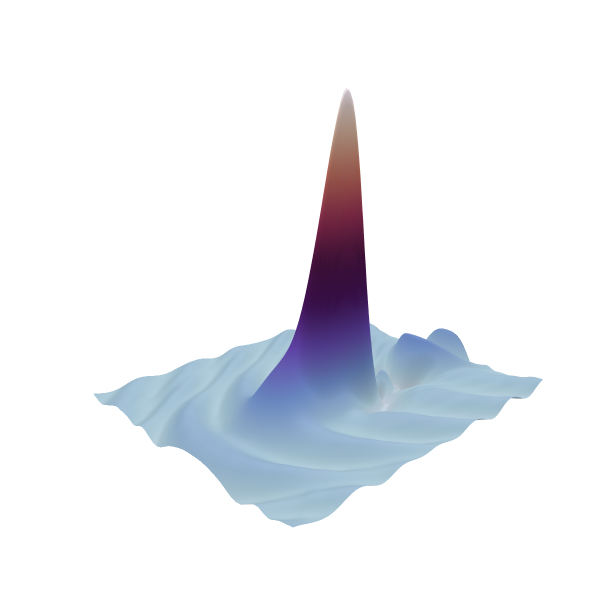Two coupled resonators#
Parameters initialization#
We import all the necessary libraries in the usual way
import matplotlib.pyplot as plt
plt.rcParams['figure.dpi'] = 150
plt.rcParams['savefig.dpi'] = 150
import numpy as np
import sys,os
my_PyCore_dir = os.path.dirname('/Users/aleksandrtusnin/Documents/Projects/PyCORe/')
sys.path.append(my_PyCore_dir)
import PyCORe_main as pcm
from scipy.constants import c, hbar
%matplotlib widget
For simplicity, we define the same dispersion for both resonators.
Num_of_modes = 2**9
mu = np.arange(-Num_of_modes/2,Num_of_modes/2)
N_res = 2
Dint = np.zeros([Num_of_modes,N_res])
D2 = 4.1e6*2*np.pi
Dint[:,0] = (mu**2*D2/2)
Dint[:,1] = (mu**2*D2/2)
Different resonators dispersion
It can be readily implemeted via
Dint[:,0] = (mu**2*D2_1/2)
Dint[:,1] = (mu**2*D2_2/2)
Defferent FSR
Let’s define the difference as \(\Delta D_1\), then it can be readily taken intro account in the dispersion as
Dint[:,0] = (mu**2*D2_1/2)
Dint[:,1] = (mu*DeltaD1 + mu**2*D2_2/2)
Resonators often have different absolute frequencies, and we usually call it as intra-resonator detuning \(\Delta\). This value depends on the material and fabrication. However, with photonic Damascene and subtractive processes it can exceed tens of GHz. Here, we detune second resonator by \(0.01\) GHz with respect to the first.
Delta = np.zeros([Num_of_modes,(N_res)])
Delta[:,1] = 2*np.pi*0.01e9*np.ones([Num_of_modes])
The evanescent coupling \(J\) depends on the the resonators’ geometry and on the distance between them. Usually, this value can be extractred from, for example, Lumerical simulations, or experiment. In PyCORe, we define it as
J = 2*1e9*2*np.pi*np.ones([mu.size,(N_res-1)])
Frequency dependent coupling
In this particular example we defined the coupling to be frequency independent, however it’s not always the case. It often has exponential dependence on the mode number \(\mu\).
We define the couplings to the bus waveguides in the similar way
kappa_ex_ampl = 20e6*2*np.pi
kappa_ex = np.zeros([Num_of_modes,N_res])
kappa_ex[:,0] = kappa_ex_ampl*np.ones([Num_of_modes])
kappa_ex[:,1] = 2*kappa_ex_ampl*np.ones([Num_of_modes])
We finally define the resonator parameters to initialize the class
omega = 2*np.pi*193.414489e12
PhysicalParameters = {'Inter-resonator_coupling': J,
'Resonator detunings' : Delta,
'n0' : 1.9,
'n2' : 2.4e-19,### m^2/W
'FSR' : 457.9e9 ,
'w0' : omega,
'width' : 2.35e-6,
'height' : 0.8e-6,
'kappa_0' : 20e6*2*np.pi,
'kappa_ex' : kappa_ex,
'Dint' : Dint}
crow = pcm.CROW()
crow.Init_From_Dict(PhysicalParameters)
Pump laser parameters and detuning parameters are defined in the similar way as for just single resonator, except there is a possibility to pump different resonators
dNu_ini = -2*1e9
dNu_end = 3e9
nn = 1000
dOm = 2*np.pi*np.linspace(dNu_ini,dNu_end,nn)
simulation_parameters = {'slow_time' : 1e-6,
'detuning_array' : dOm,
'noise_level' : 1e-9,
'output' : 'map',
'absolute_tolerance' : 1e-10,
'relative_tolerance' : 1e-12,
'max_internal_steps' : 2000}
P0 = 0.3### W
Pump = np.zeros([len(mu),N_res],dtype='complex')
Pump[0,0] = np.sqrt(P0)
map2d = crow.Propagate_PSEUDO_SPECTRAL_SAMCLIB(simulation_parameters, Pump, BC='OPEN')
f0^2 = [5682.39 0. ]
xi [-200.0,299.99999999999994] (normalized on $kappa_0/2)$
OPEN
Initializing pseudo spectral CROW
speudo spetral CROW is initialized
Step adaptative pseudo-spectral Dopri853 from NR3 without thermal effects is running
100% [||||||||||||||||||||||||||||||||||||||||||||||||||||||||||||]
Similar to the single resonator case from single-resonator example, we plot the transmission traces from both resonators
Sin = Pump/np.sqrt(hbar*PhysicalParameters['w0'])
Sout = np.zeros_like(map2d)
Sout = Sin - np.sqrt(crow.kappa_ex)*map2d/Num_of_modes
fig = plt.figure(figsize=[6,4],frameon=False,dpi=150)
ax = fig.add_subplot(1,2,1)
ax.plot(dOm[10:]/2/np.pi/1e9,np.sum(abs(Sout[10:,:,0])**2,axis=1)/np.max(abs(Sin)**2),label='1$^{\mathrm{th}}$ resonator')
ax.set_ylabel(r'Transmission $S_\mathrm{out}/S_\mathrm{in}$')
ax.set_xlabel('Pump detuning (GHz)')
plt.legend()
ax = fig.add_subplot(1,2,2)
ax.plot(dOm[10:]/2/np.pi/1e9,np.sum(abs(Sout[10:,:,1])**2,axis=1)/np.max(abs(Sin)**2),c='r',label='2$^{\mathrm{nd}}$ resonator')
ax.set_xlabel('Pump detuning (GHz)')
plt.legend()
plt.tight_layout()
The function Plot_map can also be used to interactively investigate resonator dynamics.
pcm.Plot_Map(np.fft.ifft(Sout[:,:,1],axis=1),np.arange(dOm.size),xlabel='Detuning index', units='')
